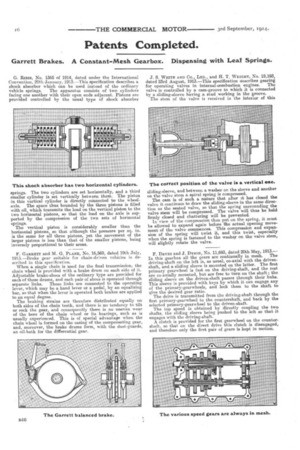Patents Completed.
Page 16

If you've noticed an error in this article please click here to report it so we can fix it.
Garrett Brakes. A Constant-Mesh Gearbox. Dispensing with Leaf Springs.
G. RIMS, No. 1365 of 1914, dated under the International Convention, 20th January, 1913.—This specification describes a shock absorber which can be used instead of the ordinary vehicle springs. The apparatus consists of two cylinders facing one another with their open ends adjacent. Pistons are provided controlled by the usual type of shock absorber springs. The two cylinders are set horizontally, and a third smaller cylinder is set vertically between them. The piston in this vertical cylinder is directly connected to the wheelaxle. The space thus bounded by the three pistons i8 filled with oil, which transmits the load on the vertical piston to the two horizontal pistons, so tha.t the load on the axle is supported by the compression of the two sets of horizontal springs. The vertical piston is considerably smaller than the horizontal pistons, so that although the pressure per sq. in. is the same for all three pistons, yet the movement of the larger pistons is less than that of the smaller pistons, being inversely proportional to their areas.
F. GARRETT and M. G. PLANE, No. 16,569, dated 19th July, 1913.—Brake gear suitable for chain-driven vehicles is described in this specification.
When a single chain is used for the final transmission, the chain wheel is provided with a brake drum on each side of it. Adjustable brake-shoes of the ordinary type are provided for each of these drums, and each pair of shoes is operated through separate links. These links are connected to the operating lever, which may be a hand lever or a pedal, by an equalizing bar, so that when the lever is operated both brakes are applied to an equal degree.
The braking strains are therefore distributed equally on both sides of the chain teeth, and there is no tendency to tilt or rock the gear, and consequently there is no uneven wear of the bore of the chain wheel or its bearings, such as is usually experienced. This is of special advantage when the chain wheel is formed on the casing of the compensating gear, and, moreover, the brake drums form, with the dust-guards, an oil-bath for the differential gear. J. S. WMTE AND CO., LTD., and H. T. WRIGHT, No. 19,193, dated 23rd August, 1913.—This specification describes gearing for operating valves in internal-combustion engines. The valve is controlled by a cam-groove to which it is connected by a sliding-sleeve having a stud working in the groove. The stem of the valve is received in the interior of this
T position of the valve is a vertical one. sliding-sleeve, correct position
between a washer on the sleeve and another
The cam is of such a nature that after it has closed the valve it continues to draw the sliding-sleeve in the same direction as the seated valve, so that the spring surrounding the valve stem will be compressed. The valve will thus be held firmly closed and chattering will be prevented.
In view of the compression thus put on the spring, it must be allowed to expand again before the actual opening movement of the valve commences. This compression and expansion of the spring will twist it, and this twist, especially when the spring is fastened to the washer on the valve stem, will slightly rotate the valve.
F. LEVES and J. DYSON, No. 11,693, dated 20th May, 1913.— In this gearbox all the gears are continually in mesh. The driving-shaft on the left is, as usual, co-axial with the drivenshaft, and a sliding sleeve is mounted on the latter. The first primary gearwheel is fast on the driving-shaft, and the rest are co-axially mounted, but are free to turn on the shaft; the sliding sleeve on the driven-shaft passes through their hubs. This sleeve is provided with keys by which it can engage any of the primary-gearwheels, and lock them to the shaft to give the desired gear ratio.
The drive is transmitted from the driving-shaft through the first primary-gearwheel to the countershaft, and back by the selected primary-gearwheel to the driven-shaft. The top speed is obtained by directly coupling the two shafts, the sliding sleeve being pushed to the left so that it engages with the driving-shaft. A clutch is provided for the first gearwheel on the countershaft, so that on the direct drive this clutch is disengaged, and therefore only the first pair of gears is kept in motion.


















